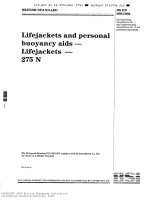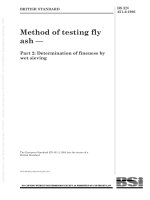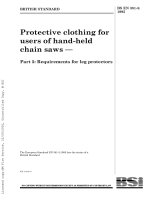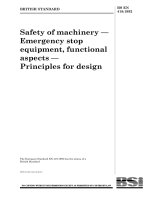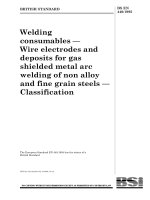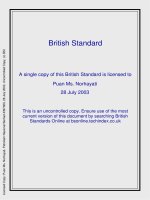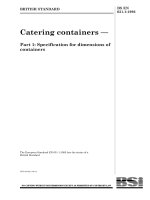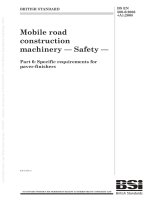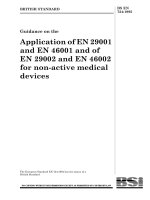Bsi bs en 60352 6 1998 (1999) iec 60352 6 1997
Bạn đang xem bản rút gọn của tài liệu. Xem và tải ngay bản đầy đủ của tài liệu tại đây (684.58 KB, 28 trang )
BRITISH STANDARD
Licensed Copy: :FULLNAME, : DATE, Uncontrolled Copy, (c) BSI
Solderless
connections —
Part 6: Solderless insulation piercing
connections — General requirements,
test methods and practical guidance
The European Standard EN 60352-6:1997 has the status of a
British Standard
ICS 31.220.10
BS EN
60352-6:1998
IEC 60352-6:
1997
BS EN 60352-6:1998
National foreword
Licensed Copy: :FULLNAME, : DATE, Uncontrolled Copy, (c) BSI
This British Standard is the English language version of EN 60352-6:1997. It
is identical with IEC 60352-6:1997.
The UK participation in its preparation was entrusted by Technical Committee
EPL/48, Electromechanical components for electronic equipment, to
Subcommittee EPL/48/2, Connectors for electronic equipment, which has the
responsibility to:
— aid enquirers to understand the text;
— present to the responsible international/European committee any
enquiries on the interpretation, or proposals for change, and keep the UK
interests informed;
— monitor related international and European developments and
promulgate them in the UK.
A list of organizations represented on this subcommittee can be obtained on
request to its secretary.
From 1 January 1997, all IEC publications have the number 60 000 added to
the old number. For instance, IEC 27-1 has been renumbered as IEC 60027-1.
For a period of time during the change over from one numbering system to the
other, publications may contain identifiers from both systems.
Cross-references
Attention is drawn to the fact that CEN and CENELEC Standards normally
include an annex which lists normative references to international
publications with their corresponding European publications. The British
Standards which implement these international or European publications may
be found in the BSI Standards Catalogue under the section entitled
“International Standards Correspondence Index”, or by using the “Find”
facility of the BSI Standards Electronic Catalogue.
A British Standard does not purport to include all the necessary provisions of
a contract. Users of British Standards are responsible for their correct
application.
Compliance with a British Standard does not of itself confer immunity
from legal obligations.
Summary of pages
This document comprises a front cover, an inside front cover, pages i and ii,
the EN title page, pages 2 to 22 and a back cover.
This standard has been updated (see copyright date) and may have had
amendments incorporated. This will be indicated in the amendment table on
the inside front cover.
This British Standard, having
been prepared under the
direction of the Electrotechnical
Sector Board, was published
under the authority of the
Standards Board and comes
into effect on
15 January 1998
© BSI 04-1999
ISBN 0 580 28739 4
Amendments issued since publication
Amd. No.
Date
Comments
BS EN 60352-6:1998
Contents
Page
Inside front cover
2
3
Licensed Copy: :FULLNAME, : DATE, Uncontrolled Copy, (c) BSI
National foreword
Foreword
Text of EN 60352-6
© BSI 04-1999
i
ii
blank
Licensed Copy: :FULLNAME, : DATE, Uncontrolled Copy, (c) BSI
EUROPEAN STANDARD
EN 60352-6
NORME EUROPÉENNE
October 1997
EUROPÄISCHE NORM
ICS 29.120.20
Licensed Copy: :FULLNAME, : DATE, Uncontrolled Copy, (c) BSI
English version
Solderless connections
Part 6: Insulation piercing connections
General requirements, test methods and practical guidance
(IEC 60352-6:1997)
Connexions sans soudure
Partie 6: Connexions à percement
d’ilsolant — Règles générales,
méthodes d’essai et guide pratique
(CEI 60352-6:1997)
Lötfreie Verbindungen
Teil 6: Durchdringverbindungen
Allgemeine Anforderungen,
Prüfverfahren und Anwendungshinweise
(IEC 60352-6:1997)
This European Standard was approved by CENELEC on 1997-10-01.
CENELEC members are bound to comply with the CEN/CENELEC Internal
Regulations which stipulate the conditions for giving this European Standard
the status of a national standard without any alteration.
Up-to-date lists and bibliographical references concerning such national
standards may be obtained on application to the Central Secretariat or to any
CENELEC member.
This European Standard exists in three official versions (English, French,
German). A version in any other language made by translation under the
responsibility of a CENELEC member into its own language and notified to the
Central Secretariat has the same status as the official versions.
CENELEC members are the national electrotechnical committees of Austria,
Belgium, Denmark, Finland, France, Germany, Greece, Iceland, Ireland, Italy,
Luxembourg, Netherlands, Norway, Portugal, Spain, Sweden, Switzerland and
United Kingdom.
CENELEC
European Committee for Electrotechnical Standardization
Comité Européen de Normalisation Electrotechnique
Europäisches Komitee für Elektrotechnische Normung
Central Secretariat: rue de Stassart 35, B-1050 Brussels
© 1997 CENELEC — All rights of exploitation in any form and by any means reserved worldwide for
CENELEC members.
Ref. No. EN 60352-6:1997 E
EN 60352-6:1997
Licensed Copy: :FULLNAME, : DATE, Uncontrolled Copy, (c) BSI
Foreword
The text of document 48B/596/FDIS, future
edition 1 of IEC 60352-6, prepared by SC 48B,
Connectors, of IEC TC 48, Electromechanical
components and mechanical structures for
electronic equipment, was submitted to the
IEC-CENELEC parallel vote and was approved by
CENELEC as EN 60352-6 on 1997-10-01.
The following dates were fixed:
— latest date by which the
EN has to be implemented
at national level by
publication of an identical
national standard or by
endorsement
(dop) 1998-07-01
— latest date by which the
national standards
conflicting with the EN
have to be withdrawn
(dow) 1998-07-01
Annexes designated “normative” are part of the
body of the standard.
In this standard, Annex ZA is normative.
Annex ZA has been added by CENELEC.
Endorsement notice
The text of the International Standard
IEC 60352-6:1997 was approved by CENELEC as a
European Standard without any modification.
Contents
Foreword
Introduction
1
Scope and object
2
Normative references
3
Definitions
4
Requirements
4.1 Workmanship
4.2 Tools
4.3 Insulation piercing terminations
4.4 Insulated conductors
4.5 Insulation piercing connections
5
Tests
5.1 Testing
5.2 Test methods and test requirements
5.3 Test schedules
6
Practical guidance
6.1 Current-carrying capacity
2
Page
2
3
3
3
4
5
5
5
5
6
6
7
7
7
13
18
18
Page
18
18
19
21
6.2 Tool information
6.3 Termination information
6.4 Conductor information
6.5 Connection information
Annex ZA (normative) Normative references
to international publications with their
corresponding European publications
Figure 1 — Example of an integrated
insulation piercing connection (one connection
shown)
Figure 2 — Example of an insulation piercing
connection with flat conductor
Figure 3 — Example of an insulation piercing
connection in a barrel with stranded wires
Figure 4 — Test arrangement, bending of single
wire
Figure 5 — Test arrangement, bending of flat
conductor, flat flexible circuitry
Figure 6 — Test arrangement, vibration
Figure 7 — Test arrangement, contact
resistance (measuring method for tinsel-wire,
flat conductor, flat flexible circuitry)
Figure 8 — Test arrangement, contact
resistance (measuring method for
stranded wires)
Figure 9 — Qualification test schedule
(see 5.3.2)
Figure 10 — Application test schedule
(see 5.3.3)
Figure 11 — Example of an insulation
piercing termination as an integral part of
a component
Figure 12 — Example of an insulation piercing
termination for flat conductor
Figure 13 — Example of an insulation piercing
termination for stranded wires
Figure 14 — Examples of round, flat and
flat oval sheath cable
Figure 15 — Example of a flexible circuitry
Figure 16 — Example of an integrated
insulation piercing connection
Figure 17 — Example of an integrated
insulation piercing connection in a barrel
with stranded wires
Table 1 — Vibration, preferred test severities
Table 2 — Contact resistance of insulation
piercing connections, maximum
permitted values
Table 3 — Number of specimens required
22
4
4
5
9
9
10
10
11
16
17
18
19
19
20
20
21
21
10
12
13
© BSI 04-1999
EN 60352-6:1997
Licensed Copy: :FULLNAME, : DATE, Uncontrolled Copy, (c) BSI
Introduction
This part of IEC 60352 includes requirements, tests and practical guidance information.
Two test schedules are provided.
The qualification test schedule applies to insulation piercing connections which conform to all
requirements of clause 4.
These requirements are derived from experience with successful applications of such insulation piercing
connections.
The application test schedule applies to insulation piercing connections which are part of a component and
are already qualified.
1 Scope and object
This part of IEC 60352 is applicable to insulation piercing connections made with stranded wires and
tinsel-wire, flat conductors and flat flexible circuitries for use in telecommunication equipment and in
electronic devices employing similar techniques.
Information on materials and data from industrial experience is included in addition to the test procedures
to provide electrically stable connections under prescribed environmental conditions.
The object of this standard is to
— determine the suitability of insulation piercing connections under specified mechanical, electrical,
and atmospheric conditions;
— provide a means of comparing test results, when the tools used to make the connections are of
different designs or manufacture.
There are different designs and materials for insulation piercing terminations in use. For this reason only
fundamental parameters of the termination, the performance requirements of the conductor and the
complete connection are specified in this standard.
2 Normative references
The following normative documents contain provisions which, through reference in this text, constitute
provisions of this part of IEC 60352. At the time of publication, the editions indicated were valid. All
normative documents are subject to revision, and parties to agreements based on this part of IEC 60352
are encouraged to investigate the possibility of applying the most recent editions of the normative
documents indicated below. Members of IEC and ISO maintain registers of currently valid International
Standards.
IEC 60050(581):1978, International Electrotechnical Vocabulary (IEV) — Chapter 581: Electromechanical
components for electronic equipment.
IEC 60068-1:1988, Environmental testing — Part 1: General and guidance Amendment 1 (1992).
IEC 60512-1:1994, Electromechanical components for electronic equipment — Basic testing procedures and
measuring methods — Part 1: General.
IEC 60512-2:1985, Electromechanical components for electronic equipment — Basic testing procedures and
measuring methods — Part 2: General examination, electrical continuity and contact resistance tests,
insulation tests and voltage stress tests Amendment 1 (1994).
IEC 60512-4:1976, Electromechanical components for electronic equipment; basic testing procedures and
measuring methods — Part 4: Dynamic stress tests.
IEC 60512-5:1992, Electromechanical components for electronic equipment; basic testing procedures and
measuring methods — Part 5: Impact tests (free components), static load tests (fixed components),
endurance tests and overload tests.
IEC 60512-6:1984, Electromechanical components for electronic equipment; basic testing procedures and
measuring methods — Part 6: Climatic tests and soldering tests.
IEC 60512-11-1:1995, Electromechanical components for electronic equipment — Basic testing procedures
and measuring methods — Part 11: Climatic tests — Section 1: Test 11 a — Climatic sequence.
IEC 60512-11-7:1996, Electromechanical components for electronic equipment — Basic testing procedures
and measuring methods — Part 11: Climatic tests — Section 7: Test 11 g: Flowing mixed gas corrosion test.
© BSI 04-1999
3
EN 60352-6:1997
Licensed Copy: :FULLNAME, : DATE, Uncontrolled Copy, (c) BSI
IEC 60512-16-20:1996, Electromechanical components for electronic equipment — Basic testing procedures
and measuring methods — Part 16: Mechanical tests on contacts and terminations — Section 20:
Test 16t: Mechanical strength (wired termination of solderless connections).
IEC 60603-7:1996, Connectors for frequencies below 3 MHz for use with printed boards — Part 7: Detail
specification for connectors, 8-way, including fixed and free connectors with common mating features, with
assessed quality.
3 Definitions
For the purposes of this part of IEC 60352, the terms and definitions of IEC 60050(581) and IEC 60512-1
and the following additional terms and definitions apply.
3.1 insulation piercing connection
A solderless connection made by suitable piercing elements, which pierce the insulation and provide
contact by deforming or penetrating the conductor. [IEV 581-03-42]
3.1.1
integrated insulation piercing connection with stranded conductor or tinsel-wire
an integrated insulation piercing connection which is part of a multipole connector
for example, for the free connector (see note) the piercing zone and its housing are integral parts of the
connection (see Figure 1)
usually all insulation piercing connections of the connector are made in one step
Figure 1 — Example of an integrated insulation piercing connection (one connection shown)
NOTE
An example for the application is the free connector according to IEC 60603-7.
3.1.2
insulation piercing connection with flat conductors or flat flexible circuitries
an insulation piercing connection formed by lances which pierce and penetrate the flat conductor
(see Figure 2)
Figure 2 — Example of an insulation piercing connection with flat conductor
4
© BSI 04-1999
EN 60352-6:1997
3.1.3
insulation piercing barrel connection with stranded conductors or tinsel-wires of discrete
wires
Licensed Copy: :FULLNAME, : DATE, Uncontrolled Copy, (c) BSI
an insulation piercing connection made by lances in a barrel which pierce the insulation, and make contact
with the conductor strands (see Figure 3)
Figure 3 — Example of an insulation piercing connection in a barrel with stranded wires
3.2
insulation piercing termination
a termination to accept different types of insulated conductors for the purpose of establishing an insulation
piercing connection [IEV 581-03-63]
3.3
insulation piercing zone
that portion of the contact designed and intended to effect the piercing of the insulation and provide contact
with the conductor (see 6.3.1) [IEV 581-03-53]
4 Requirements
4.1 Workmanship
The connections shall be processed in a careful and workmanlike manner, in accordance with good current
practice.
4.2 Tools
Tools shall be used and inspected according to the instructions given by the manufacturer(s) of the tool
and/or the connector.
The tools shall be able to make uniformly reliable insulation piercing connections during their lifetime.
The tools shall be designed to operate in such a manner that unacceptable damage to the insulation
piercing termination and/or conductors is avoided.
Hand tools shall be provided with a full cycle mechanism.
Automatic tools shall be provided with a full cycle mechanism or equivalent safeguard.
Tools are evaluated by testing insulation piercing connections made with the tools to be evaluated.
4.3 Insulation piercing terminations
4.3.1 Materials
— Metallic parts
Suitable grades of copper or copper alloy such as copper-tin (bronze), copper-zinc (brass) or beryllium
copper shall be used.
— Insulating parts
For insulation piercing connections according to 3.1.1 the component housing material shall be
polycarbonate or similar plastic material.
For insulation piercing connections according to 3.1.3 the wire insulation shall be PVC or another
material appropriate for this connecting technique.
© BSI 04-1999
5
EN 60352-6:1997
4.3.2 Dimensions
The quality of an insulation piercing connection depends on the dimensions of the insulation piercing
termination. The dimensions shall be suitable for stranded wires including tinsel-wires, insulated flat
conductors or flat flexible circuitries, as specified in 4.4.
Licensed Copy: :FULLNAME, : DATE, Uncontrolled Copy, (c) BSI
4.3.3 Surface finishes
The contact area of the termination shall be unplated or plated with tin or tin-lead or silver, gold, palladium
or their alloys.
The surface shall be free of contamination or corrosion which degrades performance.
4.3.4 Design features
Insulation piercing terminations shall be designed such that lances, peaks or sharp edges of the insulation
piercing zones penetrate the insulation of insulated conductor(s) and establish a connection by penetration
or controlled deformation of the conductor(s). The insulation piercing zones and termination body shall
deform around the conductor(s) to maintain the connection.
For insulation piercing connections according to 3.1.1 the guiding function of the component housing for
the inserted insulated wires is important.
4.4 Insulated conductors
Wires with stranded wires, tinsel-wires, flat conductors or flat flexible circuitries shall be used.
4.4.1 Materials
The conductors used shall be annealed copper.
4.4.2 Dimensions
4.4.2.1 Dimensions for insulated conductors used for insulation piercing connections according to 3.1.1
Specified in the detail specification.
4.4.2.2 Dimensions for insulated conductors used for insulation piercing connections according to 3.1.2
Specified in the detail specification.
4.4.2.3 Dimensions for insulated conductors used for insulation piercing connections according to 3.1.3
Specified in the detail specification.
4.4.3 Surface finishes
Conductors shall be unplated or plated with tin, tin-lead or silver.
The conductor surface shall be free of contamination or corrosion which degrades performance.
4.4.4 Insulation
The specification for the components using the insulation piercing termination shall specify
— the insulation thickness of the wires, and
— the outer diameters or the outer dimensions of the wires that shall be accommodated.
The insulation material shall have properties compatible with the insulation piercing process,
i.e. the insulation material shall be capable of being readily pierced by the piercing zones. In case of
stranded conductors or tinsel-wires the insulation shall additionally be capable of keeping the strands in
place so that they are not unduly moved when making the connection.
For flat cables the insulation between the conductors, including any additional insulation forming the
cable, shall additionally be capable of being readily pierced by the piercing zones.
4.5 Insulation piercing connections
a) The combination of insulated conductors, termination and connection tools shall be compatible.
b) During the connection process the insulation piercing termination of the component shall
— pierce the insulation without detrimental effect;
— deform or pierce the conductor so as to produce an electrical connection without detrimental effect
to the conductor, for example cracking.
c) The termination design shall control the relative position of the insulated conductor and the piercing
zone.
6
© BSI 04-1999
EN 60352-6:1997
Licensed Copy: :FULLNAME, : DATE, Uncontrolled Copy, (c) BSI
d) A conductor shall be correctly located in the insulation piercing termination as specified by the detail
specification. There shall be a sufficient distance between the termination and the conductor end. The
minimum value of the distance depends on the conductor used and shall be as specified by the detail
specification.
e) Where the termination is equipped with an insulation support or insulation grip, the insulation shall
be correctly located in the support or grip.
5 Tests
5.1 Testing
5.1.1 General
As explained in the introduction, there are two test schedules which shall be applied according to the
following conditions:
— insulation piercing connections which conform to all the requirements of clause 4 shall be tested and
shall meet the requirements of the qualification test schedule of 5.3.2;
— insulation piercing connections which are part of a component and are already qualified to all the
requirements of clause 4 shall be tested in accordance with and meet the requirements of the application
test schedule of 5.3.3, which shall be included in the detail specification.
5.1.2 Standard conditions for testing
Unless otherwise specified, all tests shall be carried out under standard conditions for testing, as specified
in IEC 60512-1.
The ambient temperature and the relative humidity at which the measurements are made shall be stated
in the test report.
In case of dispute about the test results, the test shall be repeated at one of the referee conditions of
IEC 60068-1.
5.1.3 Preconditioning
Where specified, the connections shall be preconditioned under standard conditions for testing for a period
of 24 h, in accordance with IEC 60512-1.
5.1.4 Recovery
Where specified, the specimens shall be allowed to recover under standard conditions for testing for a
period of 1 h to 2 h after conditioning.
5.1.5 Mounting of the specimen
a) When mounting is required in a test, the specimens shall be mounted using the normal mounting
method, unless otherwise specified.
b) The test specimen shall consist of the component having one or a specific number of insulation piercing
connections with one insulated wire inserted in each insulation piercing termination.
5.2 Test methods and test requirements
NOTE As far as test methods are described in this standard, it is intended that the description be replaced by a reference to the
appropriate part of IEC 60512 as soon as the relevant test method is included in IEC 60512.
5.2.1 General examination
The tests shall be carried out in accordance with test 1a: Visual examination, and test 1b: Examination of
dimension and mass, of IEC 60512-2. The visual examination test may be carried out with magnification
up to five times.
All parts shall be examined to ensure that the applicable requirements of 4.3 to 4.5 have been met.
5.2.2 Mechanical tests
5.2.2.1 Tensile strength
The test shall be carried out in accordance with test 16t: Mechanical strength (wired terminations of
solderless connections), of IEC 60512-16-20, Method A or Method B (as to be agreed between user and
manufacturer).
© BSI 04-1999
7
EN 60352-6:1997
Requirement:
The tensile strength of insulation piercing connections shall be not less than 20 N per wire, unless
otherwise specified by the detail specification.
Licensed Copy: :FULLNAME, : DATE, Uncontrolled Copy, (c) BSI
5.2.2.2 Bending of the wire/cable
The object of this test is to assess the ability of an insulation piercing connection to withstand the
mechanical stress caused by bending the connected insulated wire/cable, in a specified manner.
The test specimen shall consist of
— multiple connections to a multipole component. Such specimens may include multiple single wires,
wires in cable constructions or multiconductor flat cable according to 3.1.1 and 3.1.2
(see Figure 1 and Figure 2);
— a single wire connected to a single component according to 3.1.3 (see Figure 3).
The test specimen shall be securely held in such a position that the wire(s) or the flat conductor hangs along
its (their) longitudinal axis in the connection. An axial load F shall be applied to the free end of the wire(s)
or flat conductor, to keep it (them) straight.
The value of this load shall be
— 5 % to 10 % of the breaking strength of the wire where single wires are to be tested;
— 10 N to 50 N where flat conductors are to be tested. The applicable load depends on the number of
wires in the conductor, the wire diameter, the type and/or material of the insulation and shall be
specified by the detail specification. The load shall be evenly distributed over the whole conductor.
The wire shall then be bent perpendicular in both directions. A bending over the distances 1, 2 and 3 shall
be considered to be one cycle and over the distances 4, 5 and 6 shall be considered to be a further cycle
(see Figure 4). Unless otherwise specified by the detail specification the bending angle shall be 30°.
Bending of the wire/conductor shall be carried out using a suitable test arrangement, for example as
indicated in Figure 4 or Figure 5.
Where single wires connected to a multipole component are to be tested, the wire bending test shall be
carried out with a number of single wires (specimens) per component, the number to be specified by the
detail specification.
The specimens shall be tested sequentially or simultaneously as specified by the detail specification.
The number of cycles shall be 10 unless otherwise specified by the detail specification.
Contact disturbance shall be monitored during the bending test in accordance with test 2e: Contact
disturbance, of IEC 60512-2.
The limit of duration of contact disturbance shall be 1 µs unless otherwise specified by the detail
specification.
5.2.2.3 Vibration
The test shall be carried out in accordance with test 6d: Vibration, of IEC 60512-4.
The test specimen shall be firmly held on a vibration table.
An example of a suitable test arrangement for testing a component containing insulation piercing
connections is shown in Figure 6.
Contact disturbance shall be monitored during the vibration test in accordance with test 2e: Contact
disturbance, of IEC 60512-2.
The limit of duration of contact disturbance shall be 1 4s unless otherwise specified by the detail
specification.
8
© BSI 04-1999
Licensed Copy: :FULLNAME, : DATE, Uncontrolled Copy, (c) BSI
EN 60352-6:1997
Figure 4 — Test arrangement, bending of single wire
Figure 5 — Test arrangement, bending of flat conductor, flat flexible circuitry
© BSI 04-1999
9
Licensed Copy: :FULLNAME, : DATE, Uncontrolled Copy, (c) BSI
EN 60352-6:1997
Figure 6 — Test arrangement, vibration
Table 1 — Vibration, preferred test severities
10 Hz to 55 Hz
Range of frequency
Full duration
Displacement amplitude below the cross-over
frequency
Acceleration amplitude above the cross-over
frequency
Directions
Number of sweep cycles per direction
10 Hz to 500 Hz
10 Hz to 2 000 Hz
2,25 h
0,35 mm
6h
0,35 mm
7,5 h
1,5 mm
—
50 m/s2
200 m/s2
3 axes
10
3 axes
10
3 axes
10
www.bzfxw.com
Unless otherwise specified in the detail specification, the 10 Hz to 55 Hz range shall be carried out.
5.2.3 Electrical tests
5.2.3.1 Contact resistance
The test for insulation piercing connections shall be carried out in accordance with test 2a: Contact
resistance, millivolt level method, or test 2b: Contact resistance, specified test current method, of
IEC 60512-2, as specified in the detail specification.
5.2.3.1.1 Testing of insulation piercing connections with tinsel-wires, flat conductors or flexible circuitry
according to 3.1.1 and 3.1.2
A suitable test arrangement as shown in Figure 7 shall be used.
Figure 7 — Test arrangement, contact resistance (measuring method for tinsel-wire, flat
conductor, flat flexible circuitry)
10
© BSI 04-1999
Licensed Copy: :FULLNAME, : DATE, Uncontrolled Copy, (c) BSI
EN 60352-6:1997
A suitable test device may be used to ensure good contact at both measuring points. The test device should
ensure the points are located at predetermined fixed distances.
When test 2b is applied, the test current shall be 1 A/mm2 conductor cross-section. The duration of
application of the test current shall be short enough to prevent heating of the specimens.
The initial contact resistance shall be measured as reference value.
The maximum permitted change in resistance shall be specified by the detail specification.
5.2.3.1.2 Testing of insulation piercing connections with stranded conductors according to 3.1.3
A suitable test arrangement as shown in Figure 8 shall be used.
Measuring point B shall be as close as possible to the end of the wire in the insulation piercing connection
but, in the case of an open barrel, not touching the end of the wire.
NOTE
Distance X: 25 mm to 100 mm is recommended and shall be specified by the detail specification.
Figure 8 — Test arrangement, contact resistance (measuring method for stranded wires)
To achieve dependable reproducible test results, good contact to all strands at the measuring points is
necessary. By locating the measuring point D at a safe distance away from the connection, any means to
ensure the necessary good contact to all strands may be used.
A suitable test device may be used to ensure good contact at all measuring points. The test device should
ensure that the measuring points are located at predetermined fixed distances. Where test probes are used,
they shall be sufficiently rounded to avoid damaging of the conductor.
When test 2b is applied, the test current shall be 1 A/mm2 conductor cross-section. The duration of
application of the test current shall be short enough to prevent heating of the specimens.
© BSI 04-1999
11
EN 60352-6:1997
Licensed Copy: :FULLNAME, : DATE, Uncontrolled Copy, (c) BSI
The values for the maximum permitted initial contact resistance, as shown in Table 2, do not include any
resistance caused by the additional wire length, as shown in the test arrangements of Figure 8. This
additional resistance shall be subtracted from the total measured value.
The maximum permitted change in resistance is given in Table 2 unless specified in the detail specification.
Table 2 — Contact resistance of insulation piercing connections, maximum permitted values
Insulation piercing
termination
Plated
Unplated
Plated
Unplated
Conductor
Initial contact
resistance,
maximum
Maximum change in resistance after
mechanical, electrical or climatic
conditioning
m7
m7
Plated
Stranded conductor
Unplated
Plated
Flat conductor or flat
flexible circuitry
10
10
Unplated
15
10
5.2.3.2 Electrical load and temperature
The test shall be carried out in accordance with test 9b: Electrical load and temperature, of IEC 60512-5.
Unless otherwise specified by the detail specification the following details shall apply:
— maximum operating temperature
— duration
70 °C (UCT)
1 000 h
Test current shall be specified in the detail specification.
5.2.4 Climatic tests
Unless otherwise specified, the following upper category temperature (UCT) and lower category
temperature (LCT) shall be used in the following tests.
5.2.4.1 Rapid change of temperature
The test shall be carried out in accordance with test 11d: Rapid change of temperature, of IEC 60512-6
(future IEC 60512-11-4). Unless otherwise specified by the detail specification the following details shall
apply:
— low temperature
TA
– 40 °C (LCT)
— high temperature
TB
70 °C (UCT)
— duration of exposure
t1
30 min
— number of cycles
5
5.2.4.2 Climatic sequence
The test shall be carried out in accordance with test 11a: Climatic sequence, of IEC 60512-11-1. Unless
otherwise specified by the detail specification the following details shall apply:
— dry heat, test temperature
— cold, test temperature
— damp heat, remaining cycle
70 °C (UCT)
– 40 °C (LCT)
1
5.2.4.3 Flowing mixed gas corrosion test
The test shall be carried out in accordance with test 11g: Flowing mixed gas corrosion test, of
IEC 60512-11-7.
Unless otherwise specified by the detail specification, the following details shall apply:
— method 1:
— duration of exposure 10 days
NOTE
12
This test is a method with two mixed gases.
H2S:
100 ± 20 (10– 9 vol/vol)
SO2:
500 ± 100 (10– 9 vol/vol)
© BSI 04-1999
EN 60352-6:1997
5.2.4.4 Damp heat cyclic
Licensed Copy: :FULLNAME, : DATE, Uncontrolled Copy, (c) BSI
The test shall be carried out in accordance with test 11m: Damp heat, cyclic, of IEC 60512-6
(future IEC 60512-11-12). Unless otherwise specified by the detail specification the following details shall
apply:
— Test temperature
— Number of cycles
— Variant
55 °C
2
2
5.3 Test schedules
5.3.1 General
Where the requirements of the test sequence for a connector, employing these connections, include all or
part of the test requirements of this specification, duplication of testing shall be excluded.
Prior to testing, specimens shall be made. Each specimen shall consist of an insulation piercing termination
with one wire inserted in one termination, unless otherwise specified by the detail specification.
NOTE
Test 5.2.3.1.1 requires double-ended test specimens (see Figure 7).
When connections with terminations designed to be suitable for a range of wire dimensions are to be tested,
the tests shall be carried out:
a) with the number of specimens specified in Table 3, made with wires having the minimum conductor
dimensions within the range,
and, additionally,
b) with the number of specimens specified in Table 3, made with wires having the maximum conductor
dimensions within the range.
When multipole components are to be tested, the required number of specimens shall be distributed
uniformly.
Before the specimens are prepared, it shall be verified that:
a) the correct terminations and wires are used;
b) where the connections are made by tools
— the correct tool is used;
— the tool works correctly;
c) the operator is able to produce connections which comply with 4.5.
Table 3 — Number of specimens required
Test schedule
Subclause
Required in all cases, when
insulation piercing terminations
are to be tested
Additionally required when insulation
piercing terminations suitable for a
range of wire dimensions are to be
tested
Qualification test
schedule, 5.3.2
5.3.2.2.1
5.3.2.2.2
5.3.2.2.3
5.3.2.2.4
80
80
Application test
schedule, 5.3.3
5.3.3.2
40
40
5.3.2 Qualification test schedule
Where the qualification test schedule is necessary (see 5.1.1), the required number of specimens specified
in Table 3 shall be prepared and subjected to the initial examination according to 5.3.2.1.
5.3.2.1 Initial examination
All specimens required shall be subjected to test 1a: Visual examination, of IEC 60512-2
(future IEC 60512-1-1).
5.3.2.2 Testing of insulation piercing connections
80 specimens, or 2 ì 80 specimens.
â BSI 04-1999
13
EN 60352-6:1997
In those cases where the termination covers a range of wire sizes, specimens shall be selected for a
maximum wire size and an equal number for the minimum wire size within the range.
These specimens shall be divided into four test groups.
5.3.2.2.1 Test group A
Licensed Copy: :FULLNAME, : DATE, Uncontrolled Copy, (c) BSI
20 specimens, or 2 × 20 specimens, as applicable.
Test phase
Test
Title
AP1
Measurement to be performed
Subclause
Tensile
strength
Title
Mechanical
strength
5.2.2.1
Requirement
Test No. of IEC 60512
16t
Subclause
5.2.2.1
5.3.2.2.2 Test group B
20 specimens, or 2 × 20 specimens, as applicable.
Test
Test
phase
BP1
BP2
BP3
Measurement to be performed
Title
Subclause
Bending of the wire/cable 5.2.2.2
Electrical load and
5.2.3.2
temperature
BP4
Requirement
Test No. of
IEC 60512
Title
Subclause
Contact resistance
Contact disturbance
2a or 2b
2e
9b
5.2.3.1
5.2.2.2
5.2.3.2
Contact resistance
as BP1
5.2.3.1
5.3.2.2.3 Test group C
20 specimens, or 2 × 20 specimens, as applicable.
Test
Test phase
CP1
CP2
CP3
CP4
CP5
Title
Measurement to be performed
Subclause
Vibration
Rapid change of
temperature
Climatic sequence
5.2.2.3
5.2.4.1
Test No. of
IEC 60512
Title
Contact resistance
Contact disturbance
5.2.4.2
Contact resistance
2a or 2b
6d and 2e
11d
11a
as CP1
Requirement
Subclause
5.2.3.1
5.2.2.3
5.2.3.1
5.3.2.2.4 Test group D
20 specimens, or 2 × 20 specimens, as applicable.
Test
Test phase
Title
Measurement to be performed
Subclause
DP1
DP2
Title
Contact resistance
Flowing mixed gas
corrosion test
DP3
Test No. of
IEC 60512
2a or 2b
Requirement
Subclause
5.2.3.1
11g
5.2.4.3
Contact resistance
as DP1
5.2.3.1
5.3.3 Application test schedule
Where the application test schedule is applicable (see 5.1.1), the number of specimens specified in Table 3
shall be prepared and subjected to the initial examination according to 5.3.3.1.
5.3.3.1 Initial examination
All specimens shall be subjected to test 1a: Visual examination, of IEC 60512-2
(future IEC 60512-1-1).
14
© BSI 04-1999
EN 60352-6:1997
Licensed Copy: :FULLNAME, : DATE, Uncontrolled Copy, (c) BSI
5.3.3.2 Testing of insulation piercing connections
40 specimens, or 2 × 40 specimens.
In those cases where the termination covers a range of wire sizes, specimens shall be selected for a
maximum wire size and an equal number for the minimum wire size within the range.
After initial examination, 5.3.3.1, all specimens shall be divided into two test groups.
20 specimens, or 2 × 20 specimens, as applicable, shall be subjected to the following tests.
Test
Test
phase
Title
Measurement to be performed
Subclause
P1.1
Title
Test No. of
IEC 60512
2a or 2b
5.2.3.1
Contact disturbance
2e
5.2.2.2
Bending of the wire/cable
P1.3
Rapid change of temperature 5.2.4.1
11d
P1.4
Damp heat, cyclic
11m
5.2.4.4
P1.5
Subclause
Contact resistance
P1.2
5.2.2.2
Requirement
Contact resistance
as P1.1
5.2.3.1
After initial examination, 5.3.3.1, the remaining 20 specimens, or 2 × 20 specimens, as applicable, shall be
subjected to the following test.
Test
phase
P2
Test
Title
Tensile strength
Measurement to be performed
Subclause
5.2.2.1
Title
Mechanical
strength
Test No. of IEC 60512
16t
Requirement
Subclause
5.2.2.1
5.3.4 Flow charts
For quick orientation, the test schedules detailed in 5.3.2 and 5.3.3 are repeated as flow charts in a
simplified manner in Figure 9 and Figure 10.
© BSI 04-1999
15
Licensed Copy: :FULLNAME, : DATE, Uncontrolled Copy, (c) BSI
EN 60352-6:1997
Figure 9 — Qualification test schedule (see 5.3.2)
16
© BSI 04-1999
